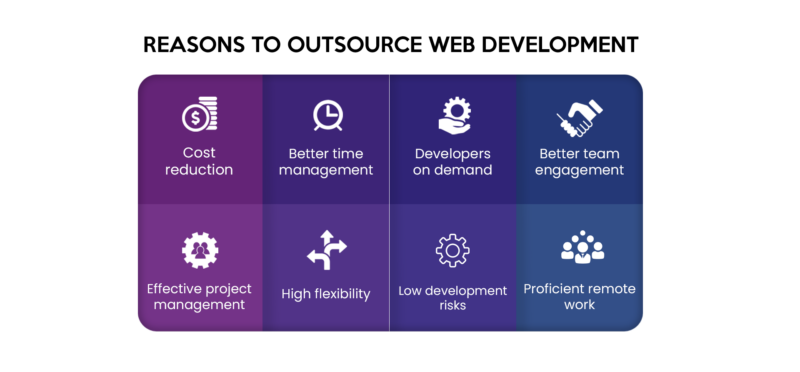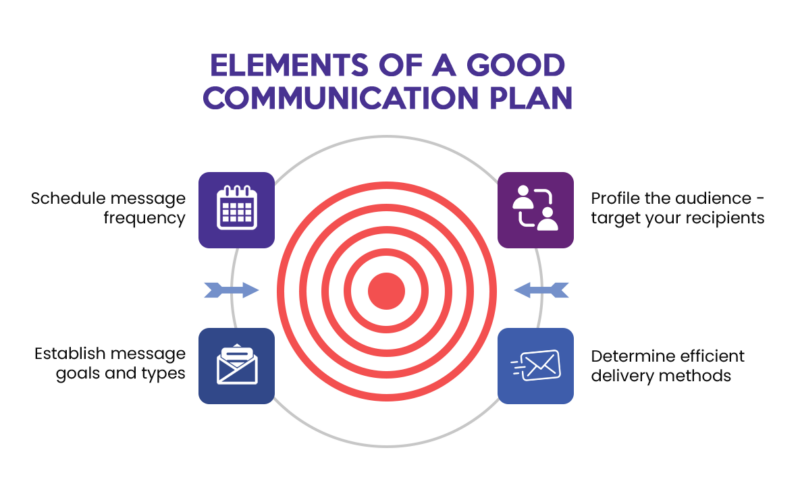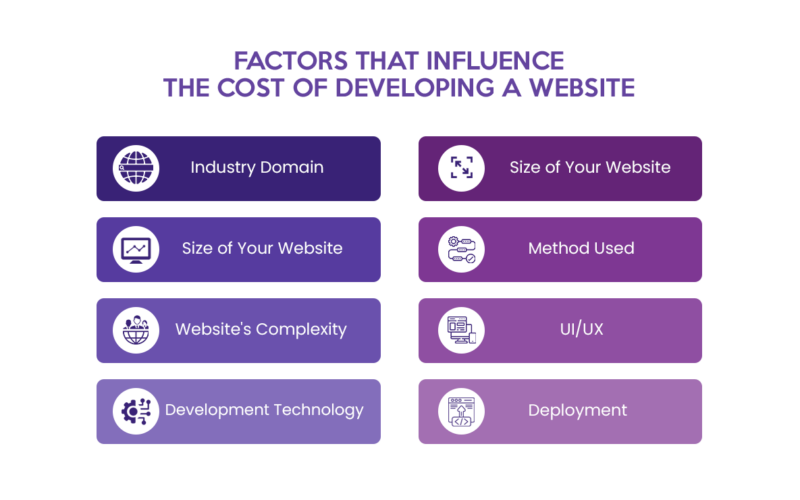Outsourcing web development is a business technique in which a company hires an external organization to handle various aspects of its web development projects. Rather than using internal resources, the company outsources the development tasks to a third-party service provider located domestically or overseas.
In the U.S., employment of web developers and digital designers is projected to grow 23% from 2021 to 2031, much faster than the average for all occupations, according to the US Bureau of Labor Statistics. Like other IT services, web development lends itself well to remote work because it does not need to be completed on-site. IT outsourcing is prevalent and accounts for the largest share of the total outsourcing sector.
This article will explore the steps to outsource web development successfully and make the most of this strategic approach.
Benefits of Outsourcing Web Development

There are numerous reasons why companies may choose to outsource web development services. Let’s look at some of the benefits in more detail.
Cost Savings
One of the main reasons companies prefer to outsource web development is the cost savings it offers. Building an in-house team of web developers can be costly because it entails recruiting, training, and providing salaries, benefits, and infrastructure. On the other hand, outsourcing allows organizations to access a pool of skilled developers at a lower cost.
Improved Customer Satisfaction
Outsourcing web development gives you access to a team of experienced individuals specializing in different parts of web development. This expertise results in higher-quality websites with better user experiences. A well-designed website can better engage customers, leading to positive brand perception.
Access to a Larger Pool of Talent
Web development is a specialized industry that requires a wide range of skills, such as coding, web design, user experience (UX), and search engine optimization (SEO). By outsourcing, businesses can obtain access to a team of web development experts with extensive experience and knowledge. This can lead to high-quality, feature-rich, and visually appealing websites.
Improved Efficiency
In-house web development projects are usually time-consuming, causing delays in the launch of a website or the implementation of updates. Businesses can speed up the process and meet deadlines through outsourcing. The dedicated development team may concentrate entirely on the web project, leveraging their experience and ability to achieve results quickly.
Steps for Outsourcing Web Development Effectively
Define your customer service needs
Understanding and documenting the specific requirements and expectations of the target audience ensures that the website aligns with the customers’ preferences, interests, and pain points. First, understand your business objectives and how the web development project fits into them. Establish the website’s goal, whether to boost online sales, raise brand awareness, or improve user experience.
Find out what your target market needs. A thorough understanding of the customer requirements enables the outsourced team to personalize the design, functionality, and customer experience to the target audience, improving customer satisfaction and engagement.
Research Outsourcing Options
You may look for web development-specific outsourcing companies online. Use search engines, social media, and professional networks to identify relevant businesses. Check reviews, ratings, and client testimonials to learn more about the company’s reputation and capabilities. Contact your professional network, who might offer trustworthy business recommendations or insightful advice based on their experience.
Review the portfolios of the web development outsourcing companies shortlisted and check if they have experience in your industry or with the specific website you want to build. Conduct interviews with representatives of the outsourcing companies, and use this to clarify any doubts, discuss the project in detail, and assess their level of expertise and professionalism.
Develop a Clear Communication Plan

A clear communication plan enables your team and the web development company to connect seamlessly, resulting in a successful project. Begin with identifying the key stakeholders involved in the web development project. This comprises internal team members from your company and representatives from the outsourced partner. Determine their roles and responsibilities in the project.
Choose the communication channels that will be used for various interactions. Email, instant messaging, project management software, or video conferencing are the common communication channels. Determine the frequency with which you will communicate about various project components. Designate persons from your internal team and the outsourced partner as communication leads. Having dedicated points of contact simplifies communication and eliminates confusion.
Lastly, foster an environment that encourages open communication and collaboration. To improve the project’s outcome, encourage all team members to express their ideas, concerns, and suggestions.
Implement and Monitor the Outsourcing Process
Designate project managers from both your organization and the web outsourcing team who will be responsible for overseeing the project’s execution, coordinating tasks, and ensuring effective communication. Specify the quality assurance and testing procedures to ensure the finished product meets the requirements. Set up regular progress meetings for status updates, issue resolution, and alignment on the project direction.
Monitor the KPIs defined at the start of the project. Seek feedback from your team and the outsourcing partner regularly to identify areas for improvement and measure the project’s success.
Recognize and celebrate accomplishments and project milestones. Recognizing accomplishments enhances team morale and provides a healthy working environment. Conduct a post-project evaluation to identify lessons learned and best practices for future outsourcing initiatives.
Factors to Consider When Outsourcing Web Development
Quality of Services
Your website is often the first point of contact for potential customers. A high-quality website enhances the user experience. Users are more likely to engage and return to well-designed, intuitive, and functional websites. Also, a professionally designed site enhances the reputation and credibility of your company.
The outsourcing company’s service quality considerably impacts the success of your web development project. A well-executed project will likely achieve its goals and meet your business requirements.
Availability and Accessibility
Availability refers to the capacity of the web development outsourcing company to allocate sufficient time and resources to your project. Working with an outsourcing provider that can take on a project and deliver based on the agreed timelines is essential. Delays in availability can result in project bottlenecks and missed deadlines.
Accessibility refers to how easily you can communicate with the outsourced team. Effective and timely communication is critical for clarifying requirements, providing feedback, and addressing concerns promptly. A responsive team ensures that concerns and inquiries are addressed quickly.
Cost

Cost is an important consideration in the project budget. By considering the cost of outsourcing, you can properly manage finances and ensure you have the resources to execute the project without exceeding your financial limits.
Understanding the cost of outsourcing allows you to assess the possible ROI of the web development project. You can determine the project’s viability and long-term advantages by weighing the predicted benefits against the costs.
While cost is important, balancing cost and service quality is critical. Choosing the cheapest option may result in quality compromises and potential problems in the long run.
Cultural Compatibility
Cultural compatibility is essential for fostering effective communication, collaboration, and a positive working relationship between your company and the outsourcing company. It helps bridge potential communication barriers caused by language differences, communication styles, or cultural norms. Understanding and respecting each other’s cultural backgrounds facilitates clearer and more effective communication.
A culturally compatible relationship creates a sense of teamwork between your in-house team and the outsourced website development team. This teamwork fosters trust and increases the project’s overall efficiency and productivity.
Tips for Successful Outsourcing Web Development
Foster Open and Clear Communication
Clear communication ensures that all parties mutually understand the project requirements. Use appropriate communication channels for your project. Email, instant messaging platforms, project management tools (e.g. Trello, Jira), and video conferencing are common options.
Plan regular meetings with the outsourcing team to discuss progress, address concerns, and provide feedback. Depending on the project’s complexity and timeline, these meetings can be daily stand-ups or weekly updates.
Foster a culture of openness and transparency where team members are comfortable sharing feedback and raising concerns. This feedback loop improves the development process by promptly handling any concerns
Maintain a consistent brand voice
Provide the outsourcing team with detailed brand guidelines that explain your brand’s personality, tone of voice, visual identity, and messaging. This document serves as a reference for the team to ensure their work is consistent with the values and style of your brand. Ensure your brand’s voice is consistent across all platforms, including your website, social media, emails, and other marketing channels. Consistency increases brand recognition and strengthens the brand’s identity.
If possible, conduct a training session with the outsourced development team, highlighting the importance of maintaining a consistent brand voice throughout the project.
Use Technology to Your Advantage
Use communication platforms like Slack, Microsoft Teams, or Discord to maintain real-time communication with the outsourcing team. Instant messaging enables quick discussions and timely responses. Store project-related files and assets on cloud-based platforms like Google Drive, OneDrive, or Dropbox. This ensures everyone has access to the latest project resources regardless of location.
Use automated testing tools to ensure the web application’s quality and functionality. Selenium, Jest, and Cypress are sample tools that can perform automatic tests, saving time and effort. To maintain the source code efficiently, use version control systems like Git. This ensures that changes can be tracked, merged, and rolled back as needed, boosting code collaboration and reducing conflict risk.
Leveraging project management tools, communication platforms, and version control systems allows seamless coordination between your internal and outsourced teams, ensuring timely updates, streamlining workflows, and effective task management.
Continuously evaluate and improve the outsourcing process
Conduct regular feedback and review sessions with the outsourced team to gather insights on the process and overall progress to identify areas of improvement. Key Performance Indicators (KPIs) must be established to measure the project’s success. Track metrics such as project timelines, budget adherence, code quality, and customer satisfaction to evaluate performance. After implementing the project, conduct a post-project evaluation to analyze the project’s strengths, weaknesses, and threats to get valuable lessons for future outsourcing projects.
Embrace a culture that sees mistakes as opportunities for growth. Learn from previous outsourcing challenges and mistakes to improve your strategy on the next projects.
Potential Challenges of Outsourcing Web Development and How to Overcome Them
Amidst the advantages of outsourcing web development services lie potential challenges that require consideration and proactive measures. Here are potential challenges of outsourcing web development and ways to overcome them:
Language Barriers
One of the most common challenges of outsourcing is the issue of language barriers. When working with a team from different linguistic backgrounds, miscommunication and misunderstandings may arise, leading to project delivery delays and compromised outcomes.
To overcome language barriers, consider the following strategies:
- Check for comprehension. Do not always assume that because the person is not asking questions, he or she understands everything. Instead of asking, “Do you understand?” when checking comprehension, you can ask questions that require more detailed responses, like “Could you please explain your plans for this project during the following week?”
- Speak at a steady pace. Interviewing potential partners over the phone or via Skype can help verify whether their English comprehension is at the level needed. To facilitate the other person’s ability to process what you are saying, maintain a steady speech rate and pause for a moment between statements.
- Define project requirements clearly. Ensure that all project requirements and specifications are simple and thoroughly documented. Avoid unclear wordings and use visual aids, diagrams, or wireframes as needed. This reduces the possibility of misunderstandings due to language barriers.
- Encourage open communication. Create a work environment that promotes open communication and fosters a culture of asking for clarification when needed. Creating a safe space for everyone to seek clarification can help avoid misunderstandings and improve overall collaboration.
Time Differences
Outsourcing web development services in other time zones can present difficulties in communication, project coordination, and meeting deadlines. Time differences can cause delays in addressing critical issues, slow feedback loops, and reduced collaboration. However, these challenges can be overcome with careful planning and the right strategies. Here are some strategies for efficiently dealing with time differences:
- Set clear expectations. In the project agreement, clearly define communication channels and response times expectations. Ensure all team members know the time designated for responding to messages and addressing critical issues.
- Set up overlapping work hours. Identify and organize overlapping work hours between your internal and the outsourced web development team. This ensures a time window each day when both teams can connect in real time, addressing critical issues and clarifying project requirements.
- Use asynchronous communication. Use asynchronous communication methods to bridge the time gap efficiently. Utilize project management tools, email, or collaboration platforms to send detailed messages, updates, and questions that the other team members can review and address during their working hours.
- Schedule weekly meetings. Conduct regular meetings at a time that is convenient for both teams. These sessions should address project status updates, upcoming tasks, and any issues or impediments encountered.
- Record meetings and discussions. When feasible, record important meetings and discussions to share with the team members who couldn’t attend in real-time. This ensures that, despite time differences, all team members are kept updated.
Maintaining Control Over the Customer Experience
Outsourcing web development can be a smart financial decision, but keeping control over customer experience is one of the primary concerns for companies. Businesses are concerned that partnering with an external team may dilute their vision and brand identity, resulting in a poor customer experience. Consider the following ways to address this challenge:
- Communicate your vision thoroughly. Clearly communicate your vision, brand values, and customer experience goals to the outsourced team. Provide documentation, style guidelines, and examples to ensure they understand your brand identity.
- Schedule regular reviews and feedback sessions. Plan regular sessions to assess the progress of the web development project. To steer development in the right direction, provide constructive feedback on design, functionality, and user experience.
- Retain core customer experience functions internally. While outsourcing web development projects, maintain control over key areas of customer experience, such as marketing strategies. This ensures consistency and alignment with your brand values.
- Prioritize quality assurance. Implement a strong quality assurance process to ensure the final product meets customer experience expectations. Gather inputs from customers and use them to improve the website or application.
Outsourcing website development can be a strategic and advantageous approach for organizations seeking to establish a strong online presence. It allows businesses to tap into a vast pool of talents, save costs, and improve efficiency and customer satisfaction.
Organizations must have clearly defined customer service needs, research their outsourcing options, develop a clear communication plan, and monitor the outsourcing process to achieve successful outcomes. Factors such as quality of services, availability and accessibility, cost, and cultural compatibility must also be considered.
Embracing outsourced web development services enables organizations to maximize their online potential, improve user experiences, and drive sustainable growth. When used effectively, businesses can harness the potential of outsourcing web development services, gaining a competitive advantage.



Leave A Comment
You must be logged in to post a comment.